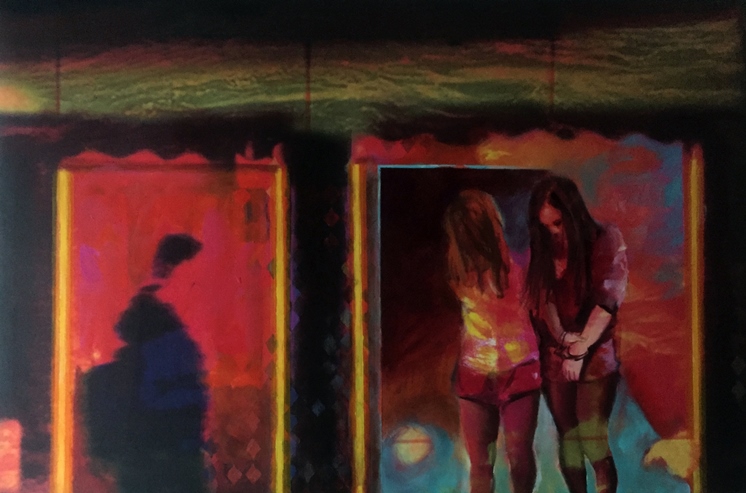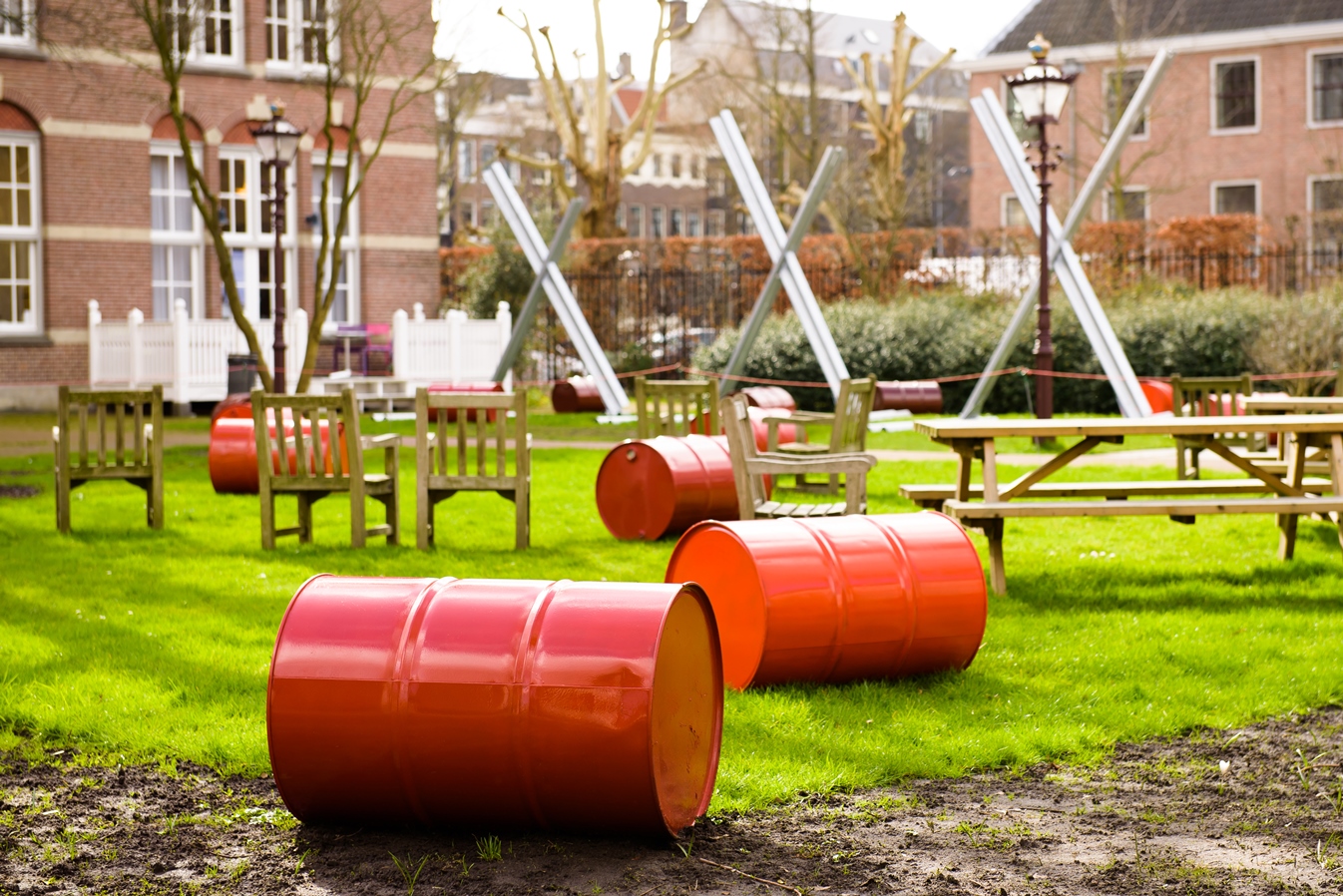Art Pilgrimage
Art Pilgrimage: A Research Project on Art Stations of the Cross
by Lieke Wijnia
During Lent 2019, the project Art Stations of the Cross took place in the historic heart of Amsterdam. Presented as a contemplative journey, fifteen Stations of the Cross were materialized through fourteen artworks displayed in thirteen locations. This unique route brought together visual art, heritage, and religion in the multi-cultural and multi-religious city of Amsterdam. As such, it offered a relevant site for academic research. In the research project “Art Pilgrimage: Aesthetic Journeys, Transformative Tracks” I conducted ethnographic research to find out how Art Stations might be understood as a form of pilgrimage and the extent to which this was fostered by the displayed art. The first findings of the research project were published in a special issue on art, symbols, and imagery of the International Journal of Religious Tourism and Pilgrimage. The article titled Relocated Pilgrimage: An Artistic Via Dolorosa in the Heart of Amsterdam is available online (open-access). This blog post touches upon some of the findings presented in the article.
Art as Station of the Cross
As a project Art Stations presents a combination of religious historical roots, established pathways, and traditional rituals with contemporary, fluid, and fragmented notions of the sacred. Since 2016, the art project has been staged annually in a major city. Through the mobilization of art and religious heritage, a novel form of pilgrimage emerges each annual edition of the route anew. The route in Amsterdam was themed Troubled Waters. It connected the narrative of the Passion of Christ with the dominance of water in the city’s history and contemporary forms of suffering relating to water, such as the refugee and climate crises.
The art route combined artworks especially made for the route with artworks associatively curated with the themes of the stations. By means of this associative curation, participants in the route were invited to attribute a Christian – or at the very least, a ritual – meaning to the artworks. While each Station had one of the traditional themes, the curated artworks did not necessarily evoke this theme. They rather evoked a variety of meanings, with people agreeing, disagreeing, or questioning the combination between the Station theme and the artwork. Still, overall the Station themes functioned as invitations for people to reflect upon both the meaning of the theme and the curated artwork.

Yona Verwer: Troubled Waters
The Station locations also played an important role. The locations were a range of museums, monumental and religious buildings. The history of such locations strongly contributed to how participants experienced the artworks. A prevalent example was Station 3, currently the Reinwardt Academie. This monumental building housed a school, of which during World War II all its Jewish pupils and staff were deported to concentration camps. In the artwork, artist Yona Verwer related the deportation of Jews to contemporary forms of human trafficking. The combination of this artwork and this particular site, in the context of a contemporary Stations of the Cross, established a strong sense of connection between past and present for many participants in the route.
In addition to such communicative combinations between artwork and location, also the overall placement of the route in the city had a significant role in how people experienced the route. As such it was also important in thinking through Art Stations as pilgrimage.
Pilgrimage in a Tourist Area
The Amsterdam edition of Art Stations was preceded by editions in London (2016), Washington DC (2017) and New York (2018). These are all urban, multi-cultural, and multi-religious contexts. They are also cities in which tourism has gained increasing impact over the last decades. The relationship between pilgrimage and tourism has long been of interest to researchers. The pilgrim and the tourist are usually seen as two separate and contrasting identities. However, more recently the intersection of these identities has come to the fore. Such an intersection was also manifest during Art Stations.

Roland Biermann adressed exploitative trade gain, especially by the oil industry
The route in its entirety was located in the historic heart of the city, five of the locations were in the red-light district. Journeying from one Station to the next, participants walked the busy, bustling canals of this area. Some experienced this as annoying, a distraction of their aim to have a reflective experience. However, many participants experienced this interaction between the contemplative route and its bustling surroundings as highly relevant in their experience of the artworks. Particularly in its connection to the various forms of suffering on display through the artworks. In walking from one Station to the next, people were confronted directly with the lived reality of themes, such as human trafficking, addressed in the artworks.
This combination of busy streets and moments of reflection is, arguably, at the heart of the Stations of the Cross tradition. Physically tied to the Via Dolorosa in Jerusalem, it is a bustling route where the Stations are located in market places and other busy sites. Therefore, the placement of the routing in Amsterdam strongly resonates to its original physical roots. The previous editions of Art Stations made use of an app, titled Alight. This app contained a spoken reflection on each of the Stations, meant for participants to listen to while walking from one Station to the next. The Amsterdam edition was the first not to incorporate the app, which, as is argued in the article, was not a disadvantage. The continuity aimed for with the app in previous editions was achieved in Amsterdam by means of the urban surroundings.
Contemporary Relevance
Many participants discussed their experiences in terms of the contemporary relevance of Christianity in general and their faith in particular. For many an interaction between religious and secular domains was achieved by means of the curation of artworks not necessarily depicting a Station theme. This was reinforced by the fact that religious themes were addressed in secular sites such as a school, museums, and a concert hall. Through the interaction of these elements many participants experienced that a public space for Christianity was claimed – albeit temporarily – which they experienced as significant in a city like Amsterdam.
For many religious participants this claimed space was logical or natural. Something they wished to see more often, whether or not in the context of the Passion. Some also expressed the desire to see a project like Art Stations to be repeated annually, in different locations and with other artworks. For them the connection between the contemporary forms of suffering and the Passion narrative reinforced the relevance of their faith. Those with no religious affiliation also greatly valued the connection between the artworks addressing current affairs in relation to the Passion narrative. They however emphasized how suffering has always been a part of human history, seeing a link between the times of Jesus and the present day. For them, the relevance was located in the human interaction between Jesus, his followers, and institutions of power. This interaction they translated to the present day, to contemporary forms of social injustice.
To be continued…
In the year 2020, the global COVID19-pandemic greatly changed the face of societal, cultural, and religious interaction. While the planned international edition of Art Stations fell through, the franchise edition in the Dutch city of Deventer did take place. As such, it became the main Art Stations routing of this year. However, due the outbreak of the global health crisis, the physical route had to close early. Curators Aniko Ouweneel and Arent Weevers turned the physical route into a digital pilgrimage – which is, unsurprisingly, another hot topic in the field of pilgrimage studies. The next, physical edition of Art Stations is planned for Toronto, Canada in 2021. Only time will tell whether this route will happen as planned or whether it will also become manifest in a different form. In any case, this artistic materialization of the Stations of the Cross tradition proves to be a relevant form of twenty-first-century pilgrimage.
***
Lieke Wijnia is Curator at Museum Catharijneconvent, Utrecht, The Netherlands. She is also affiliated as fellow with the Centre of Religion and Heritage at the University of Groningen.
The research project “Art Pilgrimage: Aesthetic Journeys, Transformative Tracks” was generously supported by the Sormanifonds and Gladstone’s Library. I thank all participants who contributed to the research project by sharing their experiences. Other publications based on the research conducted during Art Stations will be published later this year.


